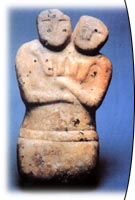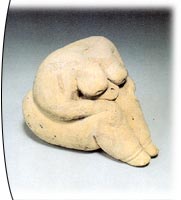Çatalhöyük
ANCIENT CITIES
Çatalhöyük
 Çatalhöyük is 10 kilometres east of Konya’s Çumra Township. The tumulus is a hill with two flat areas with different altitudes. Because of these two elevations, it is called “çatal,” meaning fork. Çatalhöyük was first discovered by J. Mellaart in 1958. There were a number of excavations here in 1961-1963 and 1965. The studies made on the western slope of the hill revealed 13 layers. The earliest settlement in the first layer dates back to 5500 B.C. This dating done by examination of style was also proved using the Carbon 14 dating method. The first settlement was a centre that sheds light on the history of humanity with the first house architecture and remains of the first sacred structures.
Çatalhöyük is 10 kilometres east of Konya’s Çumra Township. The tumulus is a hill with two flat areas with different altitudes. Because of these two elevations, it is called “çatal,” meaning fork. Çatalhöyük was first discovered by J. Mellaart in 1958. There were a number of excavations here in 1961-1963 and 1965. The studies made on the western slope of the hill revealed 13 layers. The earliest settlement in the first layer dates back to 5500 B.C. This dating done by examination of style was also proved using the Carbon 14 dating method. The first settlement was a centre that sheds light on the history of humanity with the first house architecture and remains of the first sacred structures.
The best known period of urbanization in Çatalhöyük lie between layers 7 and 11. Houses with square walls were adjacent but the houses didn’t share common walls. Every house had its own wall. Houses were planned separately and one house was built next to another whenever there was a need to do so. Because of the adjacent walls of the houses, there were no streets in the city. Walking on the flat roofs was the only means of getting around. No remains of a fortress or city walls protecting the city have been found. Sun-baked bricks, trees and reeds were used in the making of the houses. The foundations were not deep. There were wooden sticks between the walls, and the joists on these sticks supported the flat roofs. The ceilings were covered with compressed clay earth put on reeds. The houses were one story and the entrance was from a hole opening in the roof. There was a ladder going down from this opening. Every house had a room and storage. Inside the rooms, there were square stoves, stone benches which were 10-30 cm high and square niches inside the walls. The walls were plastered. After the plaster was painted white, pictures were painted on the walls using red and black dyes. Sacred rooms were relatively larger than others. Besides the pictures painted on these walls, there are also heads of bulls, rams, and deer made with compressed clay and applied to the walls. There are also reliefs of people and animals. The wall pictures in Çatalhöyük were found in layers 10 and 11. The most beautiful and sophisticated ones belong to the seventh and fifth layers. These pictures are the continuation of the tradition started by Palaeolithic man, who made pictures on cave walls. They might have also believed that these pictures would bring them luck in hunting. In later ages, we see that home decorations confined themselves to bird patterns and geometrical designs.
 The pictures also show headless people being eaten by vultures, a representation which might be related to the residents’ burial traditions. After vultures ate the flesh, the bones were collected and wrapped inside a straw cloth and buried in the house. Excavations in such places have unearthed many skeletons. Archaeologists also found gifts left for dead people such as tools made out of bones, collared stones, sharp tools, stone axes, and beads made out of seashells.
The pictures also show headless people being eaten by vultures, a representation which might be related to the residents’ burial traditions. After vultures ate the flesh, the bones were collected and wrapped inside a straw cloth and buried in the house. Excavations in such places have unearthed many skeletons. Archaeologists also found gifts left for dead people such as tools made out of bones, collared stones, sharp tools, stone axes, and beads made out of seashells.
The little figurines found during the Çatalhöyük excavations provide us with new insights about the beginning of the Mother Goddess cult and the religious beliefs of the time. These small sculptures made out of cooked clay and stone measured 5-15 cm high. The female figures are fat and buxom, with large hips. They are sometimes depicted as giving birth. These figurines represent abundance and plenitude. Stone or clay axes, plates, figurines of the goddess of fertility, bracelets and necklaces were the only tools found in Çatalhöyük. There are also black- or brick-collared cups made out of cooked clay. The figurines of the Mother Goddess and sacred animals were also made out of cooked clay. Sharp tools were made out of bones and tips of arrows and spears were made out of obsidian. These were the most important tools used in Çatalhöyük.
No excavation was done in Çatalhöyük prior to 1996. That year, the British Archaeology Institute started excavations under the leadership of Ian Hodder. The remains found are kept at the Konya Archaeology Museum. Some of these remains are being exhibited, while others are preserved in storage.